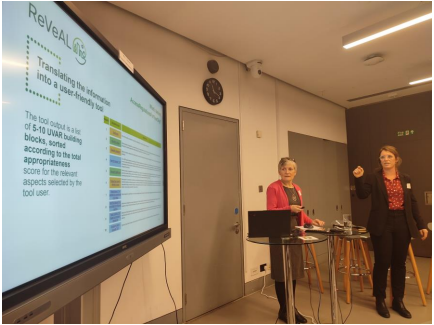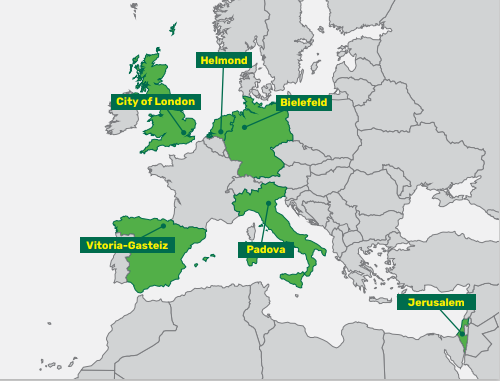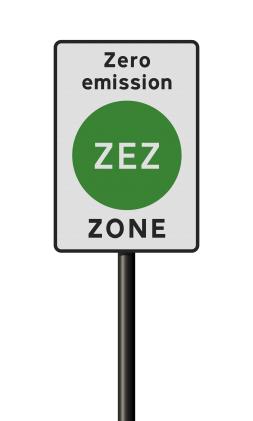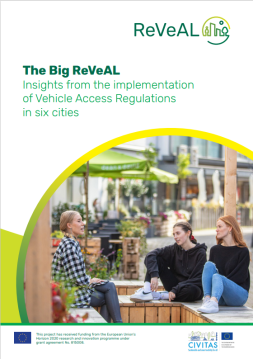- Topic
- Urban Vehicle Access Regulations
- Country
- Europe-wide
- Resource type
- Case study
First published on 10 May 2023.
Nearly one third of total urban greenhouse gas emissions in major cities is generated by transport, with air pollution responsible for significant numbers of deaths per year across the EU27 region. At the same time, the lack of accessible and affordable transport is contributing to transport poverty, particularly for some of the most vulnerable members of society.
Creating cleaner and more inclusive urban mobility is perhaps the biggest challenge facing our cities today, and many have set ambitious targets. However, big ambitions must be met with bold action to confront our car-centric transport systems by offering multi-modal transport that puts people and places first. The post-pandemic city finds itself in a unique position. The last three years have proved that the rapid transformation of urban mobility is possible, from the installation of new cycle lanes to the provision of more affordable public transport. Cities responded to COVID-19 in a decisive and resourceful way, which has set a new precedent for sustainable mobility planning.
UVARs (Urban Vehicle Access Regulations) are instrumental to achieving this. Through innovative spatial interventions such as Low Emissions Zones (LEZs), congestion charges, Limited Traffic Zones (LTZs) and superblocks[1], cities can use UVARs to create greener, safer and more inclusive streets. Cities across Europe are increasingly looking to UVARs as urban management strategies to reallocate space and prioritise active travel and public transport, while minimising access to polluting vehicles.
Context
The Horizon 2020 ReVeAL project – Regulating Vehicle Access for Improved Liveability – examined how UVARs could support cities to develop new mobility management strategies, as well as explored the associated pricing mechanisms and regulatory measures.
The project, which ran from 2019-2022, piloted measures in six cities: Helmond (NL), Jerusalem (IL), London (UK), Padova (IT), Vitoria-Gasteiz (ES) and Bielefeld (DE). From these pilots, it developed 33 building blocks for others to learn from and tailor to similar approaches in their own urban contexts.
“This project took an incredibly comprehensive approach to UVARs, acknowledging the specific social, political, economic and geographical context of a city, to explore how the process of UVAR development and enforcement can be best implemented, with many lessons for others,” says Juliette Thijs from the POLIS Network who worked on the project.
The project provided key insights for cities looking to move forward their Sustainable Urban Mobility Plans (SUMPs). As the SUMP guidelines suggest, urban mobility actions should consider relevant policy objectives, as well as transport plans that already exist or are being developed that impact on the respective urban area. As this case study explores, UVAR measures can – and must – be enacted with clear understanding of local contexts.
This built on the tools developed by the UVAR BOX and UVAR Exchange projects. UVAR Box has been supporting the private, public and commercial use of UVARs through a user-friendly tool. The project is facilitating UVAR compliance, which is especially an issue for those travelling in foreign countries and across borders. Digitisation Software providers may use the open-source UVAR Box Tool software to include UVARs. Meanwhile, UVAR Exchange is another EU-funded project which aims to identify EU-wide vehicle enforcement, produce recommendations for clearer UVAR signage and demonstrate cooperative ITS/ geofencing for car navigation systems. It created guidelines on signage for different types of UVARs including LTZs and pedestrian zones.
In action
The pilot cities and their actions
Bielefeld old town, in Germany, combined a range of UVAR measures to test the feasibility and acceptance of measures to reduce car use. Significant stakeholder involvement, including by restaurant and shop owners and road users, and well-planned measures ensured that the scheme was accepted. Today, the city is using the results of the old town pilots to implement permanent changes and expand its UVAR measures.
As part of ReVeAL, the Municipality of Jerusalem, in Israel, expanded its Low Emission Zone (LEZ) in 2020 to the entire city area (covering 125 km2) and added light diesel vehicles (those weighing less than 3.5 tonnes) to the list of banned vehicles. It also regulated construction vehicles when it became clear that a comparatively small number of vehicles were having a disproportionately adverse effect on air quality in the city.
Through its innovative ‘living lab’ approach, Helmond, in the Netherlands, demonstrated how a new neighbourhood could be turned into a zero-emission zone (ZEZ). It tested innovative road safety technology to support the city’s sustainable transport ambitions and UVAR implementation. The use of Intelligent Speed Adaptation (ISA) technologies was tested on 10 vehicles to assess their impact on traffic speeds and to collect information on drivers’ perceptions. Driver feedback offered insights into public acceptance of these new technologies: while not all feedback was positive, many drivers found ISA helped improve safety in 30 km zones. Data were also collected on the impact of the introduction of vehicles equipped with ISA on peak speeds.
By trialling a ZEZ, the City of London, UK, provided a blueprint for how an entire city could accelerate its current UVAR framework. The City of London launched a ZEZ pilot that covered multiple roads, including Bishopsgate, Leadenhall Street and Beech Street. The tested measures included vehicle bans lasting from 7am to 7pm, improved cycling infrastructure, the installation of pedestrian priority signs, and one-way streets with contraflow cycling lanes.
Padova, in Italy, introduced a superblock model to improve the area around a school and added new requirements, such as those relating to the emissions of vehicles, to the characteristics of their existing Limited Traffic Zone (LTZ). The first action taken was to transform Padova’s historical centre from an LTZ to a LEZ. The second action was to implement a superblock in Guizza, one of the southernmost districts of the city. The city identified several streets around Piazzale Cuoco and the “Ricci Curbastro” primary school, which were deemed appropriate for such redevelopment. The city implemented a new local circulation plan and created a network of one-way streets with a speed limit of 30 km/h accompanied by street furniture close to the school to almost eliminate traffic, and as a result space was reallocated for active travel.
Vitoria-Gasteiz, in Spain, embarked on improving both mobility and public spaces in line with its SUMP. To do this, they implemented two superblock projects. The first was in Arquillos, an important part of the central superblock in the area of the Memorial Centre for the Victims of Terrorism, and the second was in the superblock of Médico Tornay Street and the surrounding area.
Results
UVAR measures are incredibly disparate and encompass a range of interventions used in the urban landscape to regulate vehicle access. The ReVeAL project identified three different approaches to UVARs:
- Spatial interventions: measures that change the physical design and allocation of road space in the city, creating spaces which vehicles cannot access. These could be roadblocks, parklets, the reallocation of road or parking space to walking, cycling or various types of mobility hubs.
- Pricing aspects: measures that involve payments related to vehicle users’ access to a given area. Pricing can apply to all vehicles in an area (e.g. a congestion charge), certain categories of vehicles (e.g. a charge based on emissions standards or vehicle size), parked vehicles (various forms of parking charges) and may include permit fees and fines for non-compliance. Pricing can be flat or use variable rates.
- Regulatory measures: measures that apply restrictions, regulations and bans on vehicles according to their characteristics. Restrictions may be by emissions (low- or zero-emission) or by type of vehicle or trip taken. Non-compliant vehicles would not be allowed into the regulated area and their owners/users could face a fine if they enter.
Challenges, opportunities and transferability
“Cities across the world are all asking the same questions: how can I keep my city healthy, active and have nice places to live? This is the issue we have addressed across this project, with the aim of ensuring cities know the processes involved, encouraging, inspiring and supporting them to take the same steps our pilot cities here today have done.” says Sidharta Gautama, University of Ghent, speaking at the project’s final conference.
Throughout the project, the six cities undertook a range of different approaches to UVAR implementation, often requiring significant changes to their pilot projects. The onset of the Covid-19 pandemic forced some cities to take a radically different approach than initially planned. However, these learning curves demonstrate useful lessons for other cities (and regions) that seek to implement UVARs, such as:
- Be sure the UVAR has a goal. It is important to communicate clearly and often that the purpose of implementing the UVAR is not to penalise people but to solve a common problem and pursue a goal for the common good.
- Understand the problems, formulate goals and pursue them with the simplest available measures. UVARs can solve a range of problems but must be tailored to the specific challenge. This can include reducing high levels of pollution, congestion or noise or improving safety. Cities should first develop a vision that puts people, their lives, health and happiness at the forefront.
- Engage with those who will be affected. Early and regular participation and the involvement of residents and stakeholders is needed to create an UVAR scheme that is fine-tuned to local conditions so that it can be effective and publicly accepted.
- Increase the attractiveness of alternative mobility options. Ideally it is better to create attractive, safe and affordable public transport and walking and cycling options before an access regulation scheme is implemented. However, to prompt behavioural change, a balanced combination of push and pull measures is needed.
- Make exemptions clear, fair and limit themed. UVAR schemes should be easy to communicate. At the same time, they should not ignore the many variations in people’s physical, financial and other abilities. It would be unreasonable to expect people with disabilities, people who work in certain locations or people who need regular medical treatment to travel without a car or to purchase a different type of car.
- Use data and measure the difference between the before and after. Reliable data makes it possible to decide how to effectively tackle the problem. This requires knowledge about the severity of the problem and the underlying cause. For example, how much are heavy trucks responsible for the local air quality or private diesel cars? This links clearly to the development of SUMPs and is therefore good practice for wider mobility planning too. Indeed, as the guidelines for SUMPs outline, such plans should provide a comprehensive review of the current situation and establish a baseline through an 'urban mobility performance audit' against which future progress can be measured.
- Look for local UVAR champions. Champions (individuals who publicly promote the UVAR scheme) should be respected members of their community, be it faith-based, social, business, sports, cultural, ability-based or simply a neighbourhood.
- Plan for the future of the UVAR scheme. Legal frameworks and technological possibilities can change over time. UVAR measures may need to be adapted to new situations. For example, an ultra-LEZ may also serve to reduce the overall number of vehicles in the area but as the number of electric vehicles increases, this “positive side effect” will disappear.
In Depth
You can find out more on the links below:
ONLINE-The-big-ReveAL-16.11.2022.pdf (civitas-reveal.eu)
REVEAL-Final-Conference-Report-Final.pdf (civitas-reveal.eu)
[1] A superblock is an area of urban land bounded by arterial roads; within the superblock, the local road network, if any, is designed to serve local needs only, the streets inside serving as public squares for the neighbourhood, widespread pedestrianisation and comprehensive traffic calming (Polis 2022)
Author: Isobel Duxfield
Views and opinions expressed are those of the author(s) and do not reflect those of the European Commission.
Photo credits: ReVeAL project and Thomas Pajot © / Shutterstock.com - no permission to re-use image(s) without separate licence from Shutterstock.





